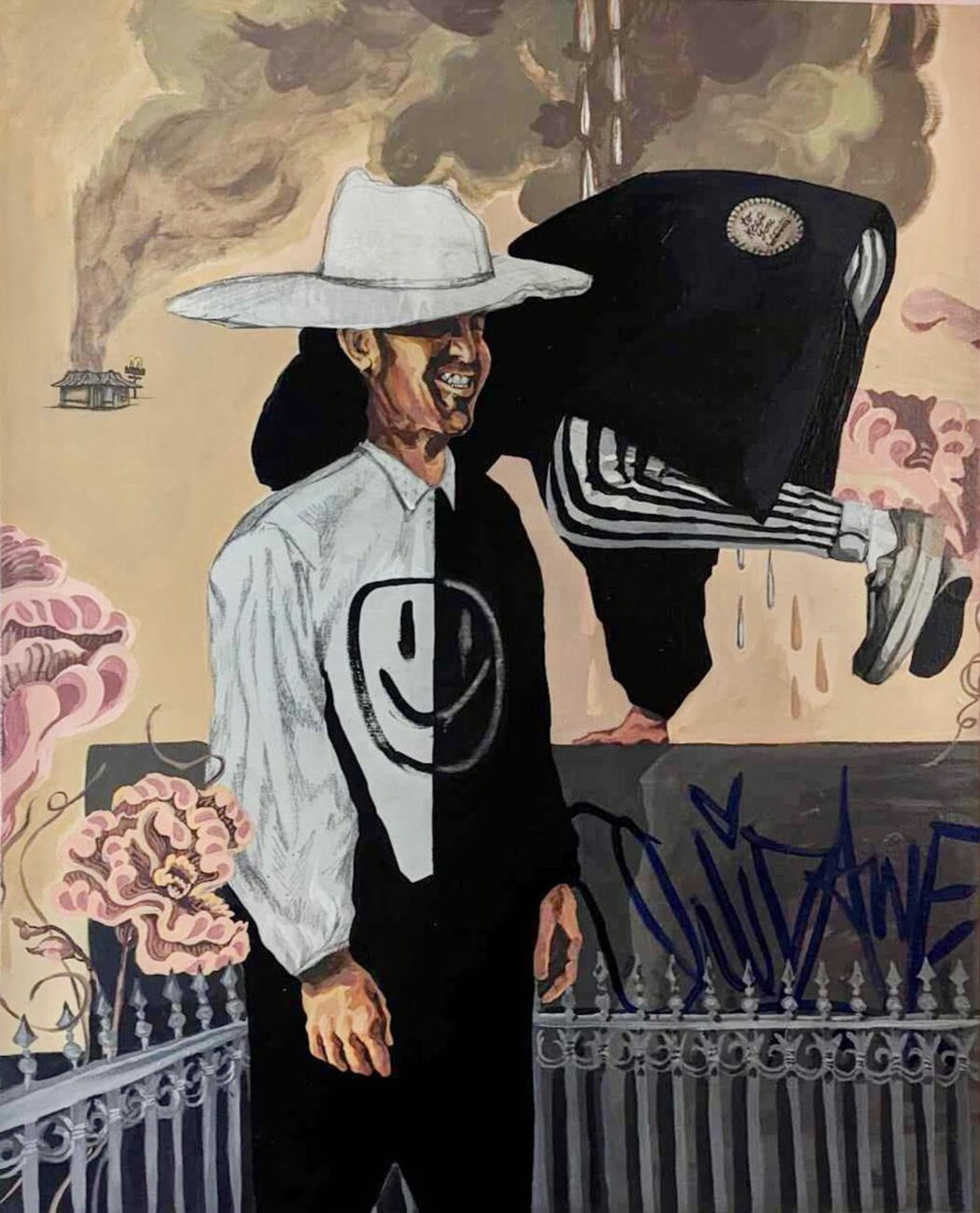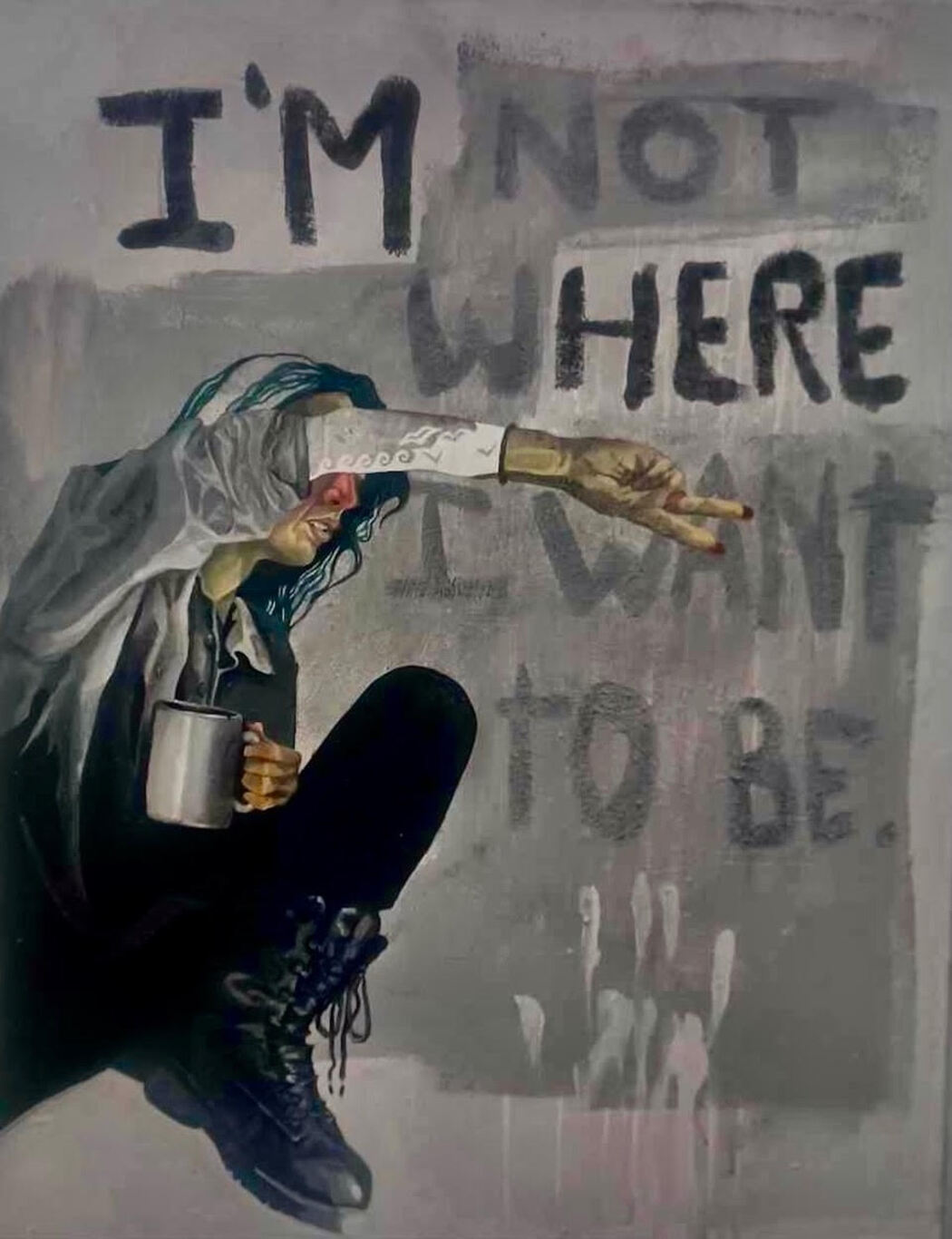Quidame Vidvil
Born in Montréal, Québec. 1989.
Bachelor’s degree in French Literature and lots of education through peers and community.
I use mostly acrylic paint but also include silkscreen work and lead pencil.
Instagram
How did your journey from literature to visual arts influence your artistic expression?
I always keep in mind that what I’m trying to convey is actually a story—a narrative. When I think I’m done with a painting, the big question is whether the story comes through. I see each piece as a little novel, believing that an image is worth a thousand words. Although sometimes, I’ll throw in actual words to drive the meaning home when I feel like the message is too muddled and needs some clarity.
Your series delves deeply into trauma and healing. What personal experiences have inspired this body of work?
I won’t dive into all the ugly details, but I’ll say I’m the lonely child of a nasty divorce that pulled me toward dangerous people. It ended with me being put in a juvenile center until I turned eighteen. I also struggled with substance abuse from my teens into my early thirties. Like many people, I’ve faced trauma and spent years trying to cope in self-destructive ways, which only deepened my pain. But through it all, painting has been my anchor—a way to reconnect with myself and unpack my true feelings in a safe space. When I finally started to turn my life around, I realized I could use art to explore the darker corners of my healing, to face my hurts and hopes, and to share the raw struggles and small victories of learning to know myself without shame. Healing those wounds is a lot like developing an art practice: It takes time, resilience, and the grit to face the discomfort that comes with growth. In this body of work, it goes in a lot of different directions within this spectrum.
How do your travels and diverse experiences as a translator and event planner shape your creative process?
At first, it was all about “getting out” and trying to validate my existence through the world around me. But somewhere along the way, I learned to understand people. I’ve been lucky enough to connect with all kinds of folks—from street kids to wealthy elites—who let me into their lives. This experience opened my mind to different opinions and viewpoints, showing me how our surroundings shape our perceptions and how those perceptions shape our reality. I realized that everyone thinks they’re the good guy from their angle. Traveling forced me out of my comfort zone and helped me build both tenacity and adaptability. It made me face my own boundaries. In the end, no matter what you’re doing, you need to be flexible enough to handle the messiness of human interactions and self-aware enough to set clear limits. Being open to different perspectives is crucial; if you can’t do that, you risk becoming an intolerant jerk.
You use both tattooing and silkscreening alongside painting. How do these mediums influence each other in your work?
Diversity means everything to me. When I paint, I often think about tattooing: both should be “clear,” need solid composition, a good grasp of color theory, and, most importantly, a real understanding of light. My characters often rock tattoos, and I like to think my tattoo work sharpens my painting skills and vice versa. Silkscreening, like tattooing, is something I picked up in the underground scene, mostly as a side hustle. It feels like “real people” art—accessible, wearable, and identity-driven. My characters often wear patches that reflect this vibe, and sometimes I even throw in actual silkscreen work to add texture and pay tribute to artists who did this before me, like Jean-Michel Basquiat and Andy Warhol. I’m really drawn to the tension between what’s unique and what’s everywhere—the idea that something can be both one-of-a-kind and part of something larger. This struggle fascinates me and shapes my work, as I dive into how “individuality” needs to coexist on an equal footing with “community.”
Your artwork features industrial architecture intertwined with nature. Could you explain the symbolism behind this combination?
Like a lot of people in the West, I find this era of late-stage capitalism really uncomfortable. Our society feels so disconnected from nature in every sense, and I can’t shake the disgust I have for our harsh, self-suppressing way of life. I guess you could say I’m a doomer; I can’t help but see parallels between my world and ancient Rome, which now exists only as ruins that nature is slowly reclaiming, and the bitter memory of something that could have been great but turned shitty. I’m also playing with the idea that the walls I build to protect myself from past wounds, anxiety, and avoidance are starting to crumble. Those man-made structures inside me are falling apart, making way for something more raw and wild. It’s messy, but it feels essential to embrace that chaos and authenticity.
How do you approach the challenge of conveying complex emotions and experiences, like trauma, through visual art?
The best way to approach it? Don’t overthink it—let your gut lead the way. Just jump into what you feel like creating without questioning why. The meaning will come later, and then you can refine it with your technical skills to make it resonate with others. For me, it’s all about getting everything out first. Let it be weird and confusing—get all that stuff out of your system before you try to make sense of it. Art is therapy for every artist. You don’t have to understand what you’re doing when you start; just trust that the meaning will show up once you clear the space inside yourself to hear it.
How do you find a balance between the destruction and renewal themes in your art?
Isn’t life just a constant cycle of destruction and renewal? There’s no way around it. Finding balance means accepting that fact. When you’re creating, don’t be afraid to start over. Let go of what you’ve made. If something on the canvas used to feel good but doesn’t anymore, don’t hesitate to change or erase it. Trust yourself: if you created it once, you can do it again. By ditching what no longer serves you, you make room for fresh ideas—stuff that truly reflects who you are and what you want to say right now. That’s how you grow as an artist and as a person. That’s how you embrace renewal.



Leave a Reply